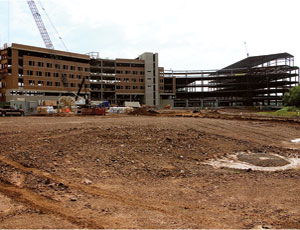These days, revenue is a deceiving gauge of market conditions. Many top contractors reported record revenue for 2008 and they expect to finish out this year with strong numbers as they consume backlog built up in better times. But as jobs won during the boom reach completion, the reality of today’s troubled market is settling in, leaving large firms nervous about what late 2010 and 2011 could bring.


Turner Construction Co., New York City, finished off 2008 with a record revenue of $9.6 billion and Senior Vice President Nick Makes expects this year’s revenue to fall just short of that mark. Going forward is a different story. With financing still tight and many developers remaining cautious this year, Makes estimates the volume of projects the company would typically pursue is down by at least 25%. “That makes for a more challenging time in 2010 and 2011,” he says. “I am hopeful that 2011 will mark a point when work will head back up again.”
The story is similar at Gilbane Building Co., Providence, R.I., which logged a record year for sales and backlog in 2008 and then saw new sales suffer in early 2009. Al Potter, chief strategy officer at Gilbane, says concerns are further compounded by owners putting the brakes on existing projects. “The challenge we face is that while sales have recovered some, we continue to have projects get deferred, canceled or delayed,” he says. “We feel like we are holding a leaking bucket and we are trying to fill it back up enough to keep the water level up.”
The most visible casualty of the frozen credit markets is the commercial sector, where contractors see few opportunities in private-office, retail and the once-hot mixed-use markets. Although base building is at a virtual standstill, Makes says interiors work continues as landlords try to retain tenants and attract new ones. “Historically, our interiors division has been about 15% of our business,” he says. “Going forward, it will be more like 25% or more.”
Greg Nook, executive vice president at JE Dunn Construction Group, Kansas City, Mo., says he sees some signs of hope for the commercial sector on the horizon. “If you look at Wall Street, corporate America reported better earnings [over the summer] than expected,” he says. “We are seeing relatively good activity in the corporate market as some of the people operating in that Fortune 1000 world are beginning to look down the road at reinvestment.”
In the meantime, many commercial contractors are migrating to the more stable institutional market. With more players taking aim at a limited flock of opportunities, competition is fierce and pricing is aggressive.
The K-12 education market has become particularly crowded. Mike Bolen, chairman and CEO of McCarthy, St. Louis, Mo., says bidders have tripled or quadrupled on K-12 work, as contractors that previously banked on commercial and residential jobs look to fill the void. “We see the big guys coming down and the little guys coming up,” he says. “On the sub-$8 million jobs, we see smaller guys from the residential sector that manage to get their bonding companies to underwrite [the job]. Then you go to bid a $50-million project for a major urban school district and it looks like the Top 10 list from ENR.”
McCarthy is busy with an $86-million renovation of Carlsbad High School in Carlsbad, Calif. The project is funded through a $198-million bond measure passed by voters last fall. The project includes 99,000 sq ft of space for classrooms, performing arts, vocational education, lab and food service, as well as a 3,900-seat stadium. Final completion is slated for fall 2011.
Despite massive budget shortfalls in California, Los Angeles Unified School District’s $20-billion construction and modernization plan remains a major source of work. It awarded $1.8 billion of projects in 2008 and expects to let another $1 billion this year. In January, LAUSD selected Turner to manage construction of the new 210,000-sq-ft $90-million Central Region High School #16. Turner also is serving as the general contractor for the LAUSD Valley Region High School #5 in San Fernando, the Central Region High School #13 in Los Angeles and the Sara Coughlin Elementary School in Pacoima.
In the higher-education sector, some projects at public universities continue to move while private institutions struggle to find funding. “The higher-ed market was hit by the substantial reductions in endowments at private [institutions] that forced most to put a freeze on capital expenditures,” Potter says. “Some are starting...


Post a comment to this article
Report Abusive Comment